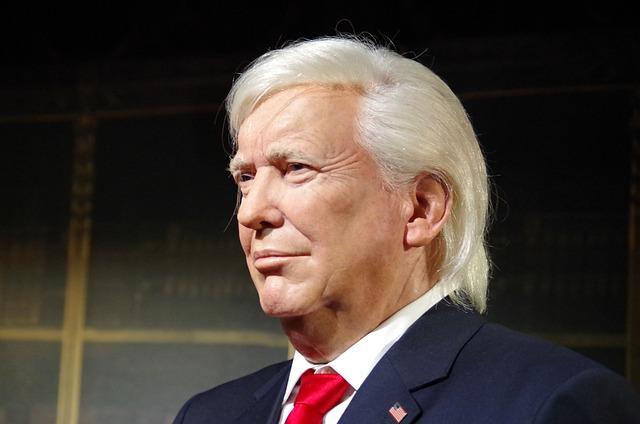In a rapidly shifting global landscape, the United States’ foreign aid policies play a crucial role in shaping international alliances adn maintaining influence across key regions. However,President Donald Trump’s recent decision to freeze foreign aid has sparked concern among policymakers and analysts alike,as it could inadvertently create a meaningful chance for rival powers,particularly China,to expand their presence and assert their influence on the world stage. While the Trump governance’s rationale for the aid freeze may center around fiscal conservatism and prioritizing domestic investments, the broader implications for U.S. foreign relations and global power dynamics warrant close examination. As nations reassess their strategic partnerships in light of this aid freeze, China is poised to capitalize on the vacuum left by the U.S., potentially redefining geopolitical alignments and reshaping the flow of international support for years to come. This article delves into the potential consequences of Trump’s foreign aid freeze and explores how it may inadvertently bolster China’s ambitions and influence around the globe.
Impact of Foreign Aid Freeze on Global Alliances
The recent freeze on foreign aid by the Trump administration has significant implications for global alliances, particularly for nations reliant on U.S.financial support. As countries reassess their partnerships, they may turn to alternative powers for assistance, notably china, which has positioned itself as a willing and able partner in global development. This shift could facilitate China’s ambitions to expand its influence in regions traditionally aligned with the United States. Critical areas impacted by this realignment include:
Development Projects: China’s Belt and Road Initiative is poised to attract countries seeking infrastructure investments previously funded by U.S. aid.
Political Collaborations: Nations may seek closer ties with Beijing, potentially compromising U.S. interests in international policy.
Economic Dependencies: The financial support gap left by the U.S. could led to increased economic dependencies on China in exchange for investments.
Additionally, the freeze could cause long-term consequences for the U.S. standing in multilateral organizations. Countries that rely on foreign aid may push for more profound engagement with countries like China, which has demonstrated a willingness to fill the void left by the U.S. This shift could alter diplomatic relations and challenge the customary narrative of American exceptionalism. A comparison of foreign aid allocations before and after the freeze can illustrate these trends:
Year
U.S. foreign Aid (in billions)
Chinese Foreign Aid (in billions)
2019
$49
$36
2020
$50
$45
2021
$38
$56

china’s Strategic Opportunities in the Void Left by U.S. Aid
With the United States imposing a freeze on foreign aid, a notable power vacuum emerges on the international stage. This shift presents a unique opportunity for China to enhance its influence across multiple regions. Countries that once thrived on U.S. support may now look toward Chinese investments and development programs, perceiving them as viable alternatives to traditional aid. In this context, China can leverage its Belt and Road Initiative, expanding its network of trade and partnerships with nations eager for economic development and infrastructure improvement.
China’s strategic maneuvers may include:
Investment in Infrastructure: Targeting key projects in developing nations to stimulate growth and foster dependency on Chinese capital.
Diplomatic Engagement: Cultivating closer relationships with governments disillusioned by U.S. policies, presenting itself as a more reliable partner.
Cultural Diplomacy: Promoting Chinese culture and values thru educational exchanges and media initiatives to build soft power.
Resource Acquisition: Securing access to vital natural resources in regions where U.S. presence has diminished.
Region
Potential for China
U.S. Withdrawal Impact
Africa
Investment in renewable energy projects
Loss of aid could shift alliances
Latin America
Trade agreements and infrastructure development
Reduced influence leaves a gap
South Asia
Increased participation in regional security
insecurity could drive nations towards China

The Role of Soft Power in Shaping International Relations
The dynamics of international relations are increasingly influenced by the concept of soft power, which refers to the ability of a country to shape the preferences of others through attraction rather than coercion. As the United States potentially retreats from its traditional role in providing foreign aid, the implications are profound. By defunding development assistance, the U.S. might inadvertently cede ground to nations like China, which has been actively investing in soft power initiatives across the globe. Through its Belt and Road Initiative, for example, China has positioned itself as a benefactor, offering infrastructure investments and financial resources to many countries, particularly in Africa and asia. This creates a dependency that can elevate China’s status and influence on the world stage while concurrently undermining U.S. interests.
Moreover,soft power extends beyond mere financial support; it encompasses cultural exchange,educational programs,and diplomatic engagement. Countries looking to seek alternative support may favor partnerships with those who enhance their global standing through these avenues. Key factors contributing to the effectiveness of this strategy include:
Cultural Diplomacy: Promoting cultural understanding and exchange can foster goodwill and positive relations.
Economic Partnerships: Engaging in mutually beneficial trade agreements can strengthen ties.
Educational Initiatives: Scholarships and exchange programs can create lasting relationships with the younger generation.
As the landscape shifts, it is indeed vital for policymakers in the U.S. and its allies to recognise the strategic importance of soft power in maintaining their influence. As nations compete for hearts and minds across borders, the lack of a robust foreign aid program not only diminishes America’s foothold but also raises questions about its long-term diplomatic and economic strategies.

Recommendations for U.S. Policy Adjustments to Compete Effectively
to enhance U.S. competitiveness on the global stage, particularly in regions where China is gaining influence, it is crucial for policymakers to reassess and recalibrate foreign aid strategies. Instead of imposing drastic cuts,a reinvestment in strategic alliances is essential. This involves prioritizing economic assistance and creating frameworks that advance infrastructure projects, technology transfer, and capacity building in developing nations. By aligning aid with clear goals, the U.S. can effectively counter China’s growing presence and expand its influence through meaningful partnerships.
Furthermore, engaging in multilateral dialog can bolster U.S. standing by fostering coalitions that address global challenges collaboratively. This approach should include investments in education, health, and environmental sustainability, ensuring that U.S. aid is not only competitive but also ethically grounded. Policymakers should also explore the potential of public-private partnerships to maximize the impact of foreign aid.Such initiatives can attract diverse funding sources and resources, thereby enhancing U.S.effectiveness in promoting democratic values and human rights worldwide.

Assessing the Long-Term Consequences for U.S. Influence Worldwide
The freeze on foreign aid instigated by the Trump administration has raised significant questions about the future dynamics of global influence, particularly regarding U.S. standing in relation to China. As potential beneficiaries of this aid reassess their alliances and dependencies, there is a growing probability that nations previously aligned with U.S. interests may gravitate towards partnerships with China, an emerging superpower eager to expand its influence through economic support and infrastructure investments. This shift could entail several long-term ramifications:
Strategic Alliances: Countries may prioritize relationships with nations that offer immediate financial assistance over those that maintain a longer-term commitment to promoting democratic values.
Economic Influence: China’s Belt and Road Initiative could see accelerated adoption as nations seek alternatives to U.S. funding, thus altering economic landscapes across various regions.
Geopolitical Tensions: The competition for influence could lead to heightened geopolitical tensions, particularly in regions like Southeast Asia and Africa, where both nations vie for strategic partnerships.
Moreover, this geopolitical landscape has the potential to impact U.S. soft power, fundamentally altering how countries perceive American governance and policies. In the long term, if the U.S. does not adapt its foreign aid strategy and fails to present a compelling rationale for its role on the global stage, it risks diminishing its reputation and credibility. A shift in funding priorities could lead to a table of nations that indicates their growing allegiance to China over the U.S., highlighting this evolving balance of power:
Country
Current Aid Dependency
Potential Chinese Engagement
Brazil
High
Increased investment from China
Ethiopia
Moderate
Belt and Road projects
Pakistan
High
Long-term economic agreement with China

Lessons from History: Previous U.S. Foreign Aid Decisions and Their Outcomes
Historical perspectives on U.S. foreign aid offer invaluable insights into the complexities and consequences of international aid decisions. The Marshall Plan, established post-World War II, is a prominent example of how strategic aid can stabilize regions and foster long-term partnerships. Its success in rebuilding Western European economies not only curbed the influence of the Soviet Union but also set the stage for future economic alliances. In contrast, the U.S. aid response in Vietnam was mired in controversy and did not achieve the intended objectives, leading to a significant loss of credibility and influence in Southeast Asia. Such examples underline the importance of context, intent, and implementation in foreign aid decisions, which can either strengthen ties or exacerbate tensions.
As the world grapples with shifting power dynamics, the implications of foreign aid decisions are more pronounced than ever. The recent freeze on aid has opened doors for other nations,particularly China,to expand their influence through economic partnerships and infrastructure investments worldwide. Countries in need of development funds may turn to alternative sources,potentially reshaping long-held alliances. The following table summarizes notable U.S. foreign aid initiatives and their implications:
U.S. Foreign Aid Initiative
Region
Outcome
The Marshall Plan
Western Europe
Economic recovery and strengthened alliances
Military Aid to vietnam
Southeast Asia
Escalation of conflict and loss of influence
Plan Colombia
South America
Combatting drug trafficking, but regional tensions remained

Final Thoughts
President Trump’s decision to freeze foreign aid presents significant implications for global diplomacy and geopolitical alliances.As the United states reevaluates its financial commitments abroad, opportunities may arise for nations like China to extend their influence in vulnerable regions. The withdrawal of U.S. support could not only reshape existing partnerships but also embolden other nations to seek new alliances,potentially altering the balance of power on the world stage. As this situation unfolds,the global community will closely monitor how these shifts impact international relations and the strategic landscape in the years to come.
Author : Asia-News
Publish date : 2025-02-20 09:21:00
Copyright for syndicated content belongs to the linked Source.